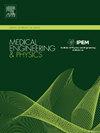The effect of bone plasticity models on simulations of primary fixation in total knee arthroplasty
IF 1.7
4区 医学
Q3 ENGINEERING, BIOMEDICAL
引用次数: 0
Abstract
Predictions of primary fixation in total knee arthroplasty (TKA) can aid in implant design, optimizing long-term survival. Finite element (FE) simulations are commonly used to assess micromotions at the bone-implant interface during daily activities, requiring accurate computational models. A key factor is the material model used to simulate bone properties. This study evaluated two plastic material models—Isotropic Crushable Foam (ICF) and softening Von-Mises (sVM)—for predicting primary fixation in femoral TKA components. Mechanical tests on human femoral trabecular bone samples under cyclic loading were replicated using FE simulations with ICF and sVM models. These models were then applied to FE simulations of three femoral TKA reconstructions, representing patients aged 57, 73, and 90 years. The ICF model replicated the gradual plastic deformation observed in experiments, unlike the sVM model, and more closely matched the permanent deformation of bone samples. In primary fixation simulations, micromotions at the bone-implant interface averaged 27 µm with ICF and 17 µm with sVM. While both predictions fall within acceptable ranges, the ICF model, as a pressure-dependent material model, more accurately replicates experimental energy dissipation and plastic deformation patterns, closely mirroring human bone's plastic behavior. This makes it better suited for simulating implant-bone interface micromotions in primary TKA fixation.
骨可塑性模型对全膝关节置换术初次固定模拟的影响
预测全膝关节置换术(TKA)的初次固定可以帮助植入物设计,优化长期生存。有限元(FE)模拟通常用于评估日常活动中骨-种植体界面的微运动,需要精确的计算模型。一个关键因素是用来模拟骨骼特性的材料模型。本研究评估了两种塑料材料模型——各向同性可破碎泡沫(ICF)和软化冯-米塞斯(sVM)——用于预测股骨TKA组件的初次固定。采用ICF模型和sVM模型对人股小梁骨样品进行循环载荷下的力学模拟。然后将这些模型应用于三个股骨TKA重建的FE模拟,分别代表57岁、73岁和90岁的患者。与sVM模型不同,ICF模型复制了实验中观察到的逐渐塑性变形,更接近于骨样品的永久变形。在初次固定模拟中,ICF和sVM在骨-种植体界面处的微运动平均为27µm和17µm。虽然这两种预测都在可接受的范围内,但ICF模型作为一种压力相关的材料模型,更准确地复制了实验能量耗散和塑性变形模式,密切反映了人骨的塑性行为。这使得它更适合于模拟初级TKA固定中种植体-骨界面微运动。
本文章由计算机程序翻译,如有差异,请以英文原文为准。
求助全文
约1分钟内获得全文
求助全文
来源期刊

Medical Engineering & Physics
工程技术-工程:生物医学
CiteScore
4.30
自引率
4.50%
发文量
172
审稿时长
3.0 months
期刊介绍:
Medical Engineering & Physics provides a forum for the publication of the latest developments in biomedical engineering, and reflects the essential multidisciplinary nature of the subject. The journal publishes in-depth critical reviews, scientific papers and technical notes. Our focus encompasses the application of the basic principles of physics and engineering to the development of medical devices and technology, with the ultimate aim of producing improvements in the quality of health care.Topics covered include biomechanics, biomaterials, mechanobiology, rehabilitation engineering, biomedical signal processing and medical device development. Medical Engineering & Physics aims to keep both engineers and clinicians abreast of the latest applications of technology to health care.
 求助内容:
求助内容: 应助结果提醒方式:
应助结果提醒方式:


